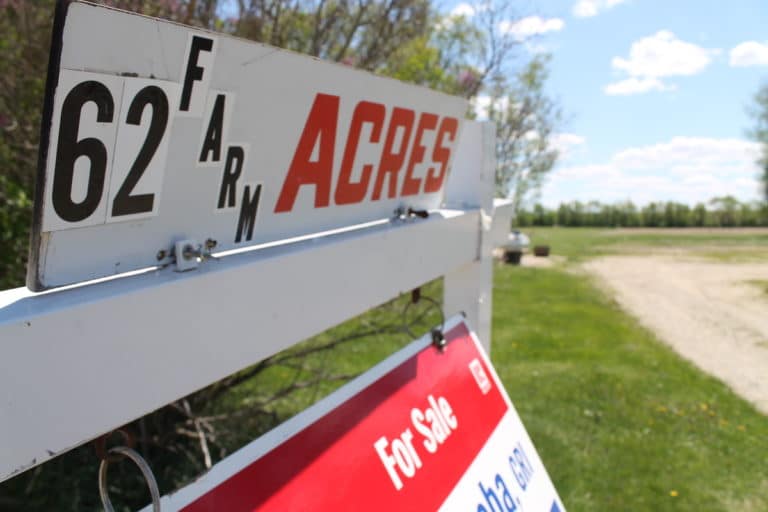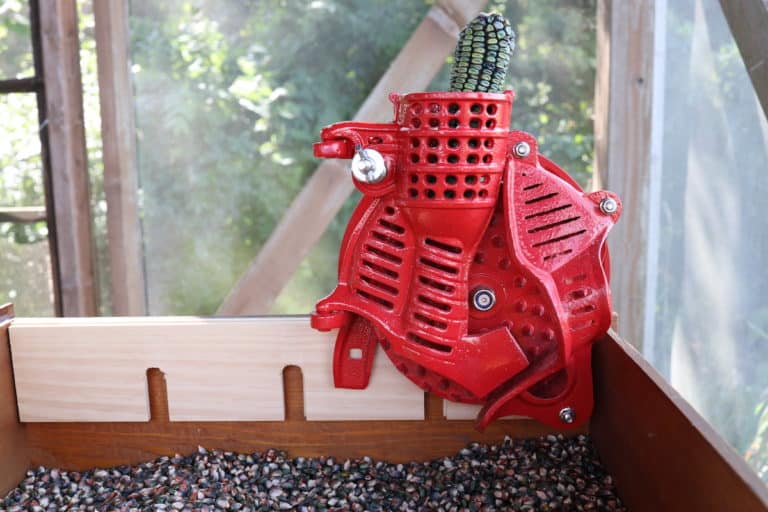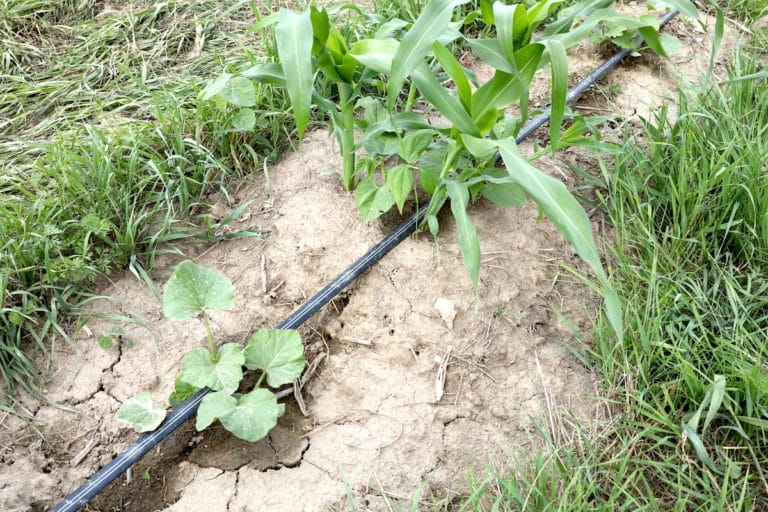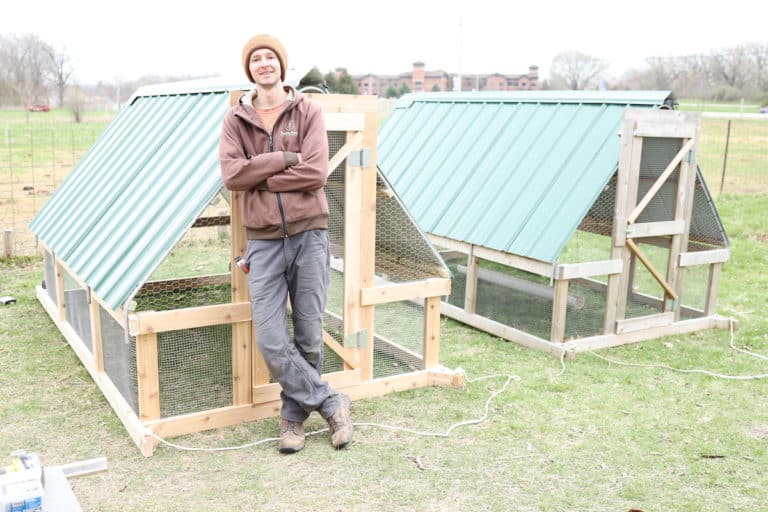Planting, Harvesting, and Curing Garlic for Storage – It’s easy!
Growing garlic is one of the favorites on our homestead and it’s way easier than you might think. We will break down best methods for planting, harvesting, and curing garlic for storage.
As a new gardener, growing garlic felt intimidating. Planting something in the fall to harvest in the spring was new territory and honestly felt like “next level” gardening. But, several years ago we took the plunge and planted our first garlic cloves in the ground and haven’t looked back since!
A big emphasis for us on our homestead is growing enough food to feed our family all year round. This means that we love to grow crops that store well. Our post—10 Essential Storage Crops You Need to Grow—goes through the main storage crops that we focus on here on our homestead.
As you might have guessed, garlic is on that list! In order for garlic to store well for the long term, once your garlic is harvested, curing is the next essential step.
Curing Garlic for Storage
Curing garlic is the process of drying garlic out for long term storage. This process usually takes 1-2 weeks. But, it can take a month or more depending on the humidity level. You will know that it’s done curing once the garlic feels dry, the outer skins are crispy, and the center stem of the garlic feels firm.
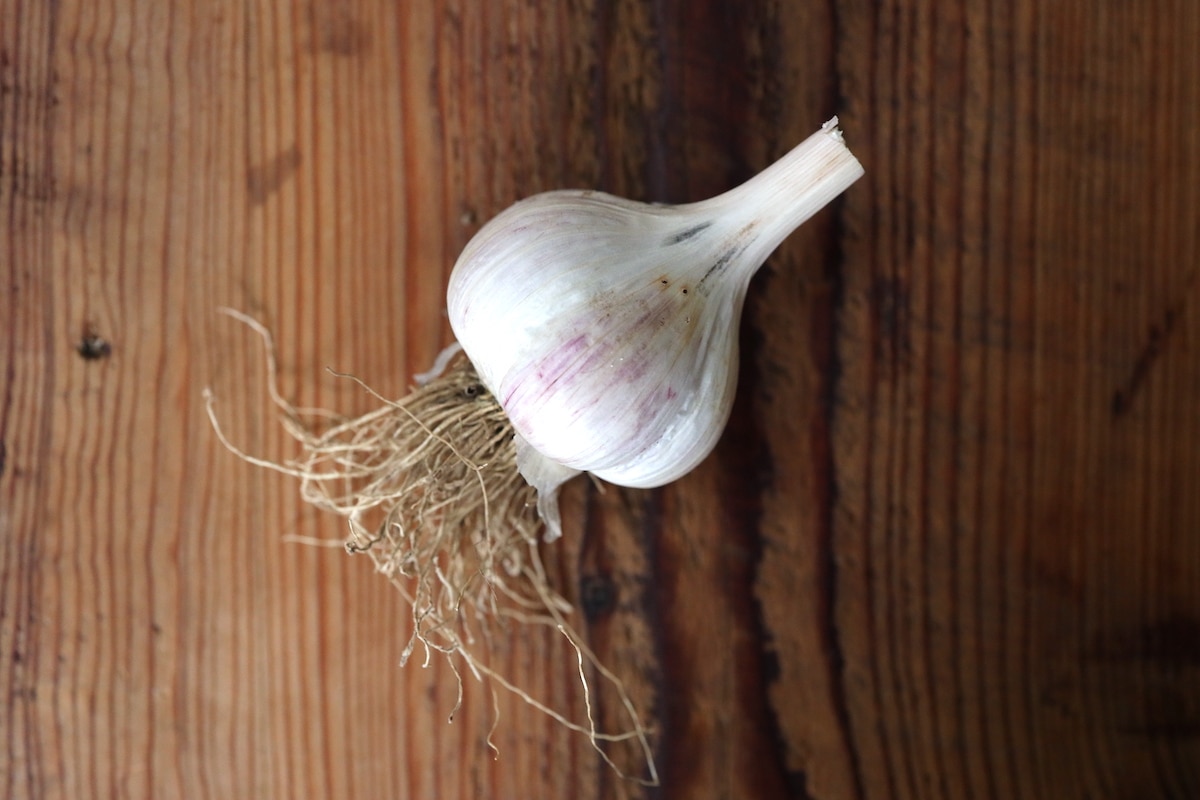
If you didn’t grow very much garlic and want to eat it up right away, then curing garlic isn’t necessary. But, if you plan to use your garlic in the future, then the step curing your garlic is essential to keep it from going bad.
Properly cured and stored garlic can last up to a year. More on storage below.
Curing Softneck vs. Hardneck Garlic
As it sounds, the necks of softneck garlic are literally soft when they are ready for harvest. This is the type of garlic that is commonly braided and hung for curing. Softneck garlic is also known for storing very well after being cured and is typically the type of garlic found in grocery stores.
Hardneck garlic is more closely related to wild garlic. The neck of hardneck garlic is stiff and brittle upon harvesting. Hardneck garlic can also be cured in an open-air bin or box, hung like softneck, or simply laid out on a surface. Just make sure the bulbs are not overcrowded and have ample airflow.
We have always grown hardneck garlic—Music variety is our favorite. To cure it, we’ve had success laying the garlic flat in food storage bins in our basement for a couple of weeks. The bins fit the stiff stems nicely and the open sides of the bins allow for ventilation.

Storing Garlic Long Term
After curing your garlic, it’s ready to be put into long term storage. The storage process is the same for hardneck or softneck varieties.
With the hardneck garlic we grow, after it is finished curing, we cut the stems 1-2” above the bulb. After the stems are cut, we remove a layer or two of the outer skin, similar to peeling an onion. This will remove any dirt or debris that may be caked onto the garlic. Again, don’t use water to rinse. Now it is ready to store for the months ahead.
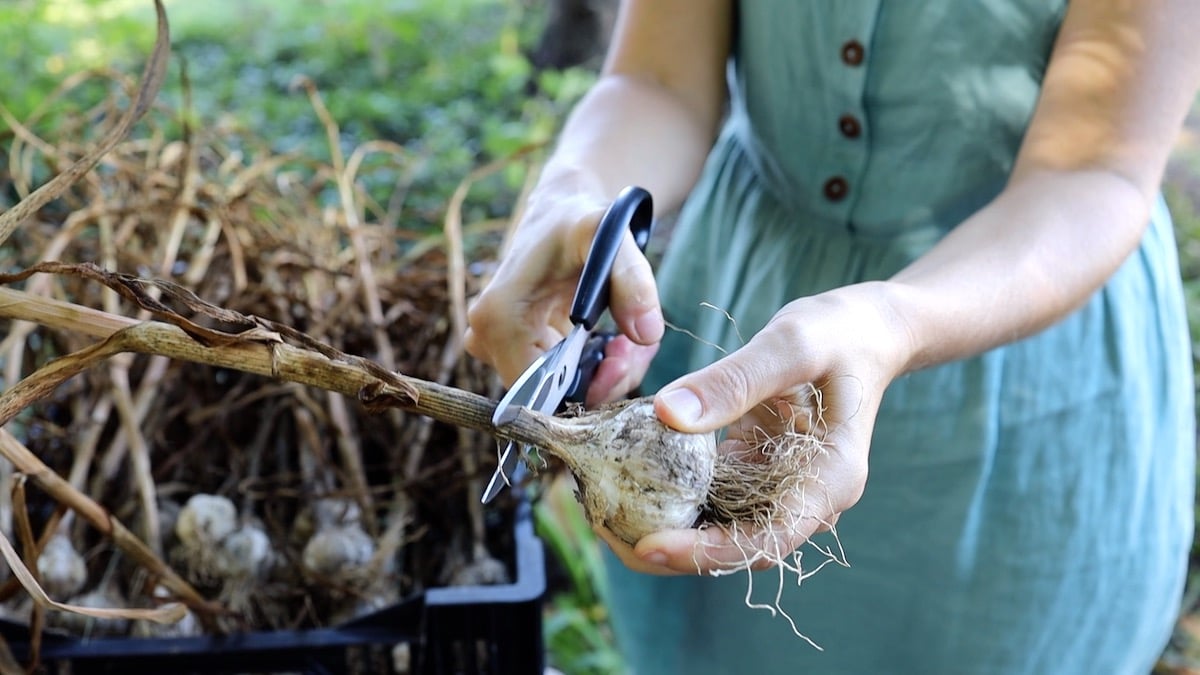
It is best to store your garlic in a dark, cool place. Ideally, the temperature would be between 35-50°F. You also want to avoid high moisture locations. Whatever they are stored in should allow for airflow. Brown paper bags are perfect for storing garlic in, or other breathable storage containers can work.
We’ve had great success storing garlic in our basement on storage shelves. We either use large brown paper bags, or open air crates with a cloth lightly draped over to block light.
Around April, you may see some garlic cloves starting to sprout. Remove those bulbs and use these first in cooking. Otherwise, we’ve found the majority of our garlic has stored well up until the following year’s garlic harvest!
What is Seed Garlic?
The first step in growing garlic is obtaining seed garlic. Garlic grows into a bulb. Each bulb contains many cloves. Garlic seed, then, is simply an individual clove out of the bulb. A garlic clove is planted into the ground and, several months later, harvested as a whole bulb of garlic!
To find garlic seed, there are several online seed companies and retailers that you could purchase from. Especially if you are looking for a unique variety of garlic, this would be the best route to go. Some of our favorites are Fedco and Baker Creek Heirloom Seeds.

Another option is to find a local farm who grows garlic with growing methods that you resonate with and purchase garlic bulbs to use as seed.
The first year we planted garlic, it was already mid to late October when we made the decision to give it a go. We reached out to local farmers in our community and were able to purchase around 7 pounds of garlic bulbs that we used for our seed garlic.
Now, several years later, we are still planting that same garlic variety (Music hardneck garlic) from the garlic bulbs that we grow ourselves.
When to Plant Garlic?
As opposed to most standard crops that are planted in the spring and harvested in the fall, garlic is unique. Garlic is typically planted in the fall and harvested in the summer months.

We are in zone 5b and our window for planting garlic falls between mid-October and early November. When to plant garlic will vary based on the climate in the area you live. Colder climates need to plant garlic as early as mid-September while warmer climates can wait until as late as December or January to plant garlic.
It is best to plant garlic at least a month before the ground freezes to give the planted garlic clove the chance to develop roots.
How to Plant Garlic?
The beauty of garlic is that it can be planted relatively close together. This means that you can grow a lot of garlic in a relatively small amount of space, making it perfect for any backyard gardener!
Additionally, it is a great crop for succession planting. Once harvested the same growing bed can be available to sow seed for late season crops such as carrots and beets, or short-season vegetable varieties like spinach and radishes.
The garlic clove should be planted roughly 3” deep and 6” apart. Plant the clove with the pointy side of the clove facing up and the flatter side down.

We like to work in a layer of compost when planting garlic. Either work your compost into the soil prior to planting, or cover over your garlic cloves with well-seasoned compost once in the ground. We have found that this has worked wonders to replenish nutrients in the soil and has led to beautiful, large bulbs of garlic.
Last, it’s a good idea to add a layer of mulch on top. Around 4-6” of straw is what we like to do. The mulch serves as a blanket of insulation during the cold winter months, allows the soil bed to warm more quickly in the spring, and acts as a layer of weed control during the growing season.
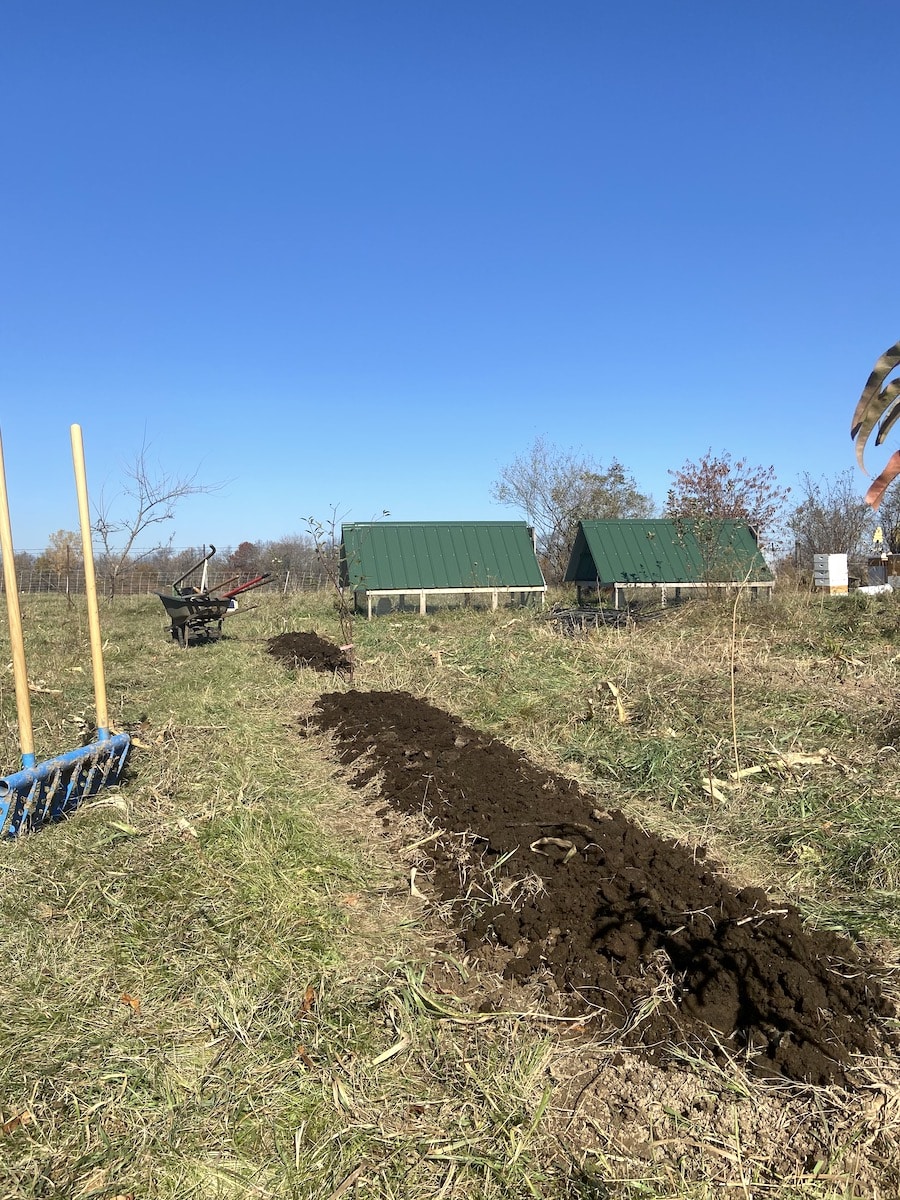
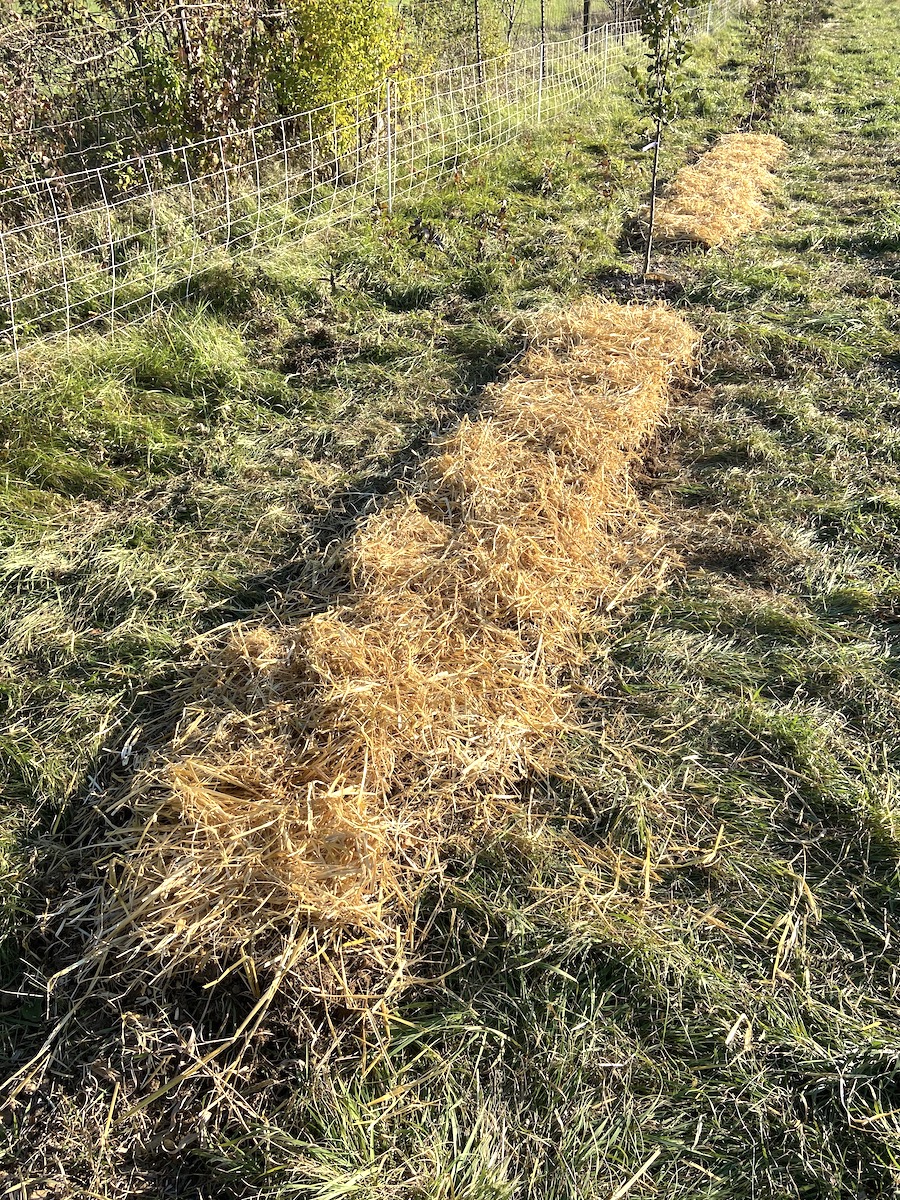
However, in the case that you do not add mulch (speaking from experience), you can still have beautiful garlic yields alongside an abundance of weeds.
After your garlic is planted in the fall, that’s it. Sit back, relax, and enjoy the winter, knowing that your garlic is hard at work. Come spring, you’ll start to see the garlic stems popping out of the ground.
Garlic Scapes – Harvest and Use Them!
By springtime, you should start to see the green garlic stems popping out of the ground. In later spring, usually mid-late June where we are in zone 5b, you will see garlic scapes begin shooting out of your garlic stems.
Garlic scapes are thin, cylindrical, curly, green shoots that emerge from the garlic stems. Harvesting garlic scapes is an important step. Doing so will help the garlic plant be able to use its energy and resources to grow the bulb of garlic instead of continuing to put that energy into growing the garlic scapes.
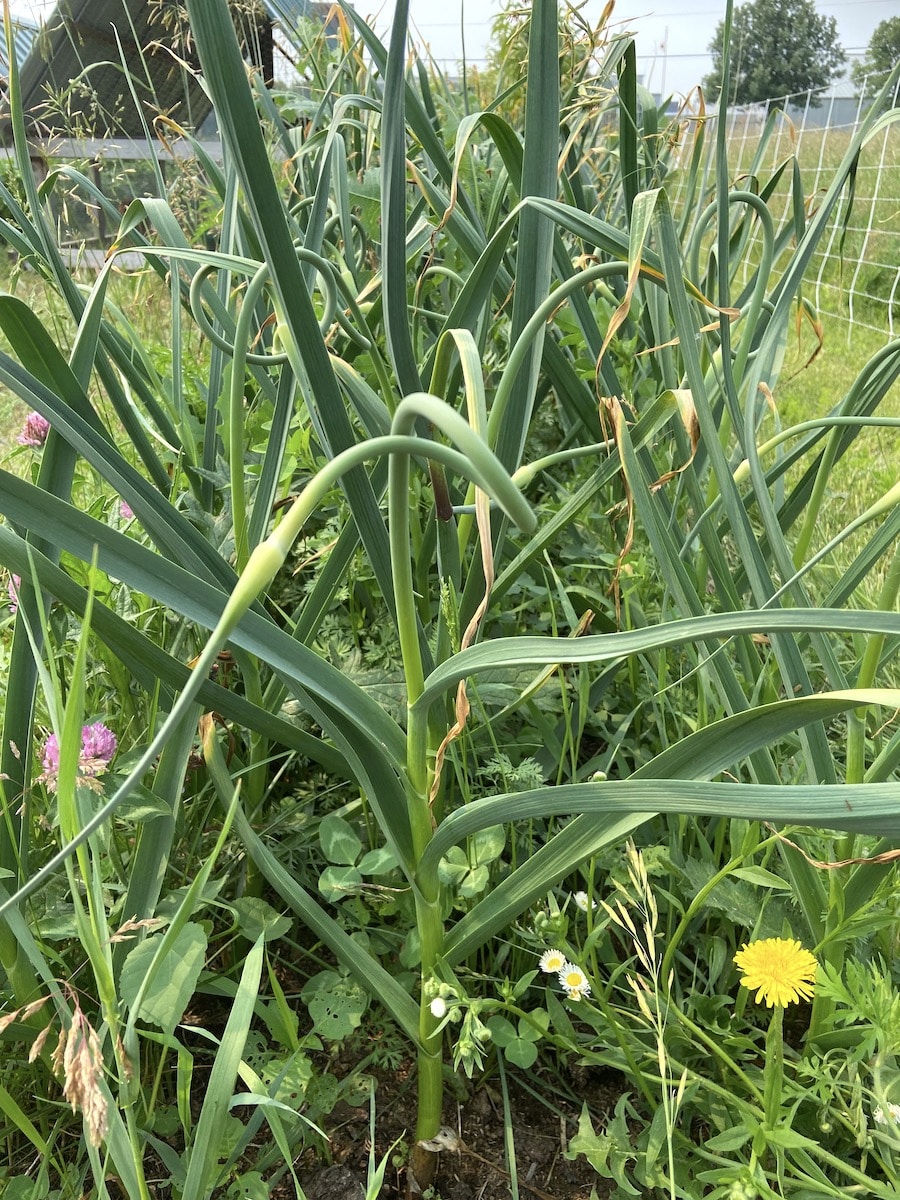
You will want to harvest scapes while they are still young to both give your plant more time to put its energy into the garlic bulb but also because the young garlic scapes are very tender and delicious for eating. If you wait to harvest them, they turn very hard and aren’t good for eating.
To harvest garlic scapes, cut the scape or gently pull the scape as low as possible as you can on the garlic plant, being carful the not yank on the garlic bulb itself or pull-out other stems.
Garlic scapes add a burst of garlicy flavor to any dish. We prefer to use them cooked into dishes like stir fries in place of adding garlic. They also work perfectly in fresh pesto.
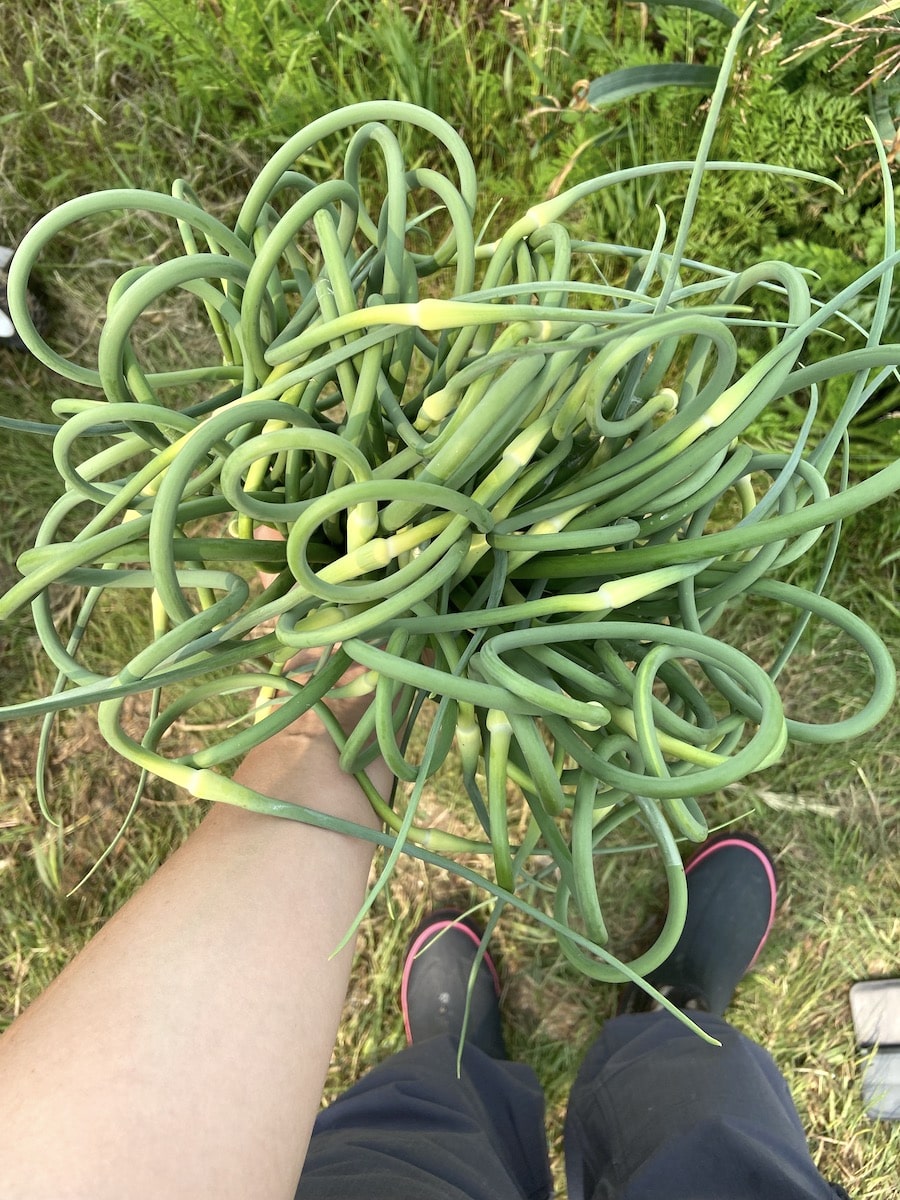
How to Harvest Garlic
Roughly 4 weeks after we harvest garlic scapes, our garlic is ready to harvest. For us in zone 5b this is around mid-late July.
To harvest garlic, gently pull the garlic bulb by the stem out of the ground. You can use a small garden shovel, if necessary, to work around the plant and help it come loose from the soil around it. However, we have found a firm but gentle pull is usually enough for the bulb and roots to release.
Once harvested, you can knock off any soil from the bulb of garlic but do not wash the garlic. For curing and storing long term it is important that the garlic remain as dry as possible.
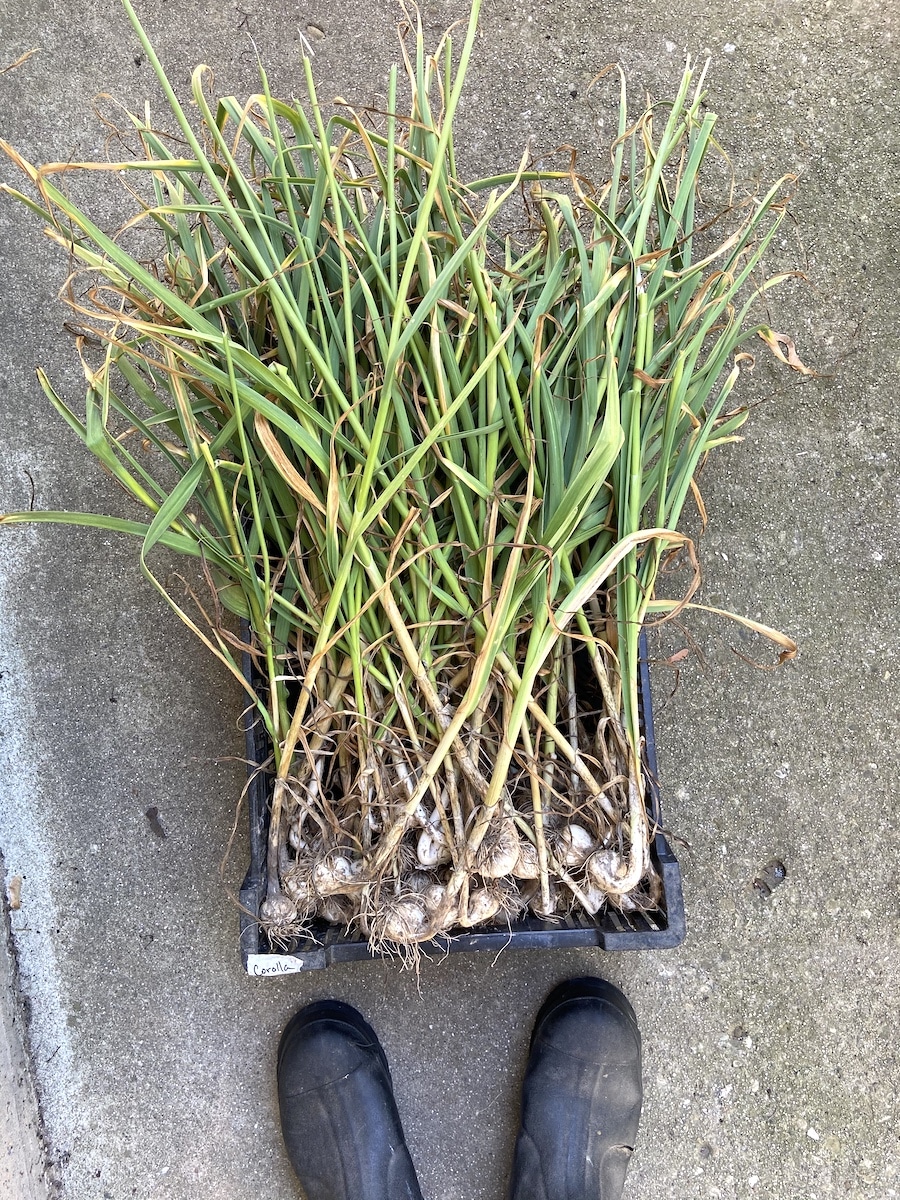
Why Grow Garlic?
There are several reasons we love growing garlic.
1. Garlic is expensive. Before growing garlic on our homestead, I rarely splurged on purchasing garlic cloves. Instead, we relied on the less expensive dried garlic powder to flavor our dishes. Now, I’m so thankful to be able to grab a bulb of garlic anytime!
2. Garlic can up your cooking game. After cooking primarily with dried garlic powder for several years, there is a noticeable and positive difference in cooking with fresh garlic! Similar recipes have considerably more depth of flavor than they previously did.
3. Other Benefits. Outside of its use in cooking, garlic has long been touted for its health and nutritional properties. Every year, we include plenty of garlic when making a large batch of fire cider to take whenever we feel a cold coming on.
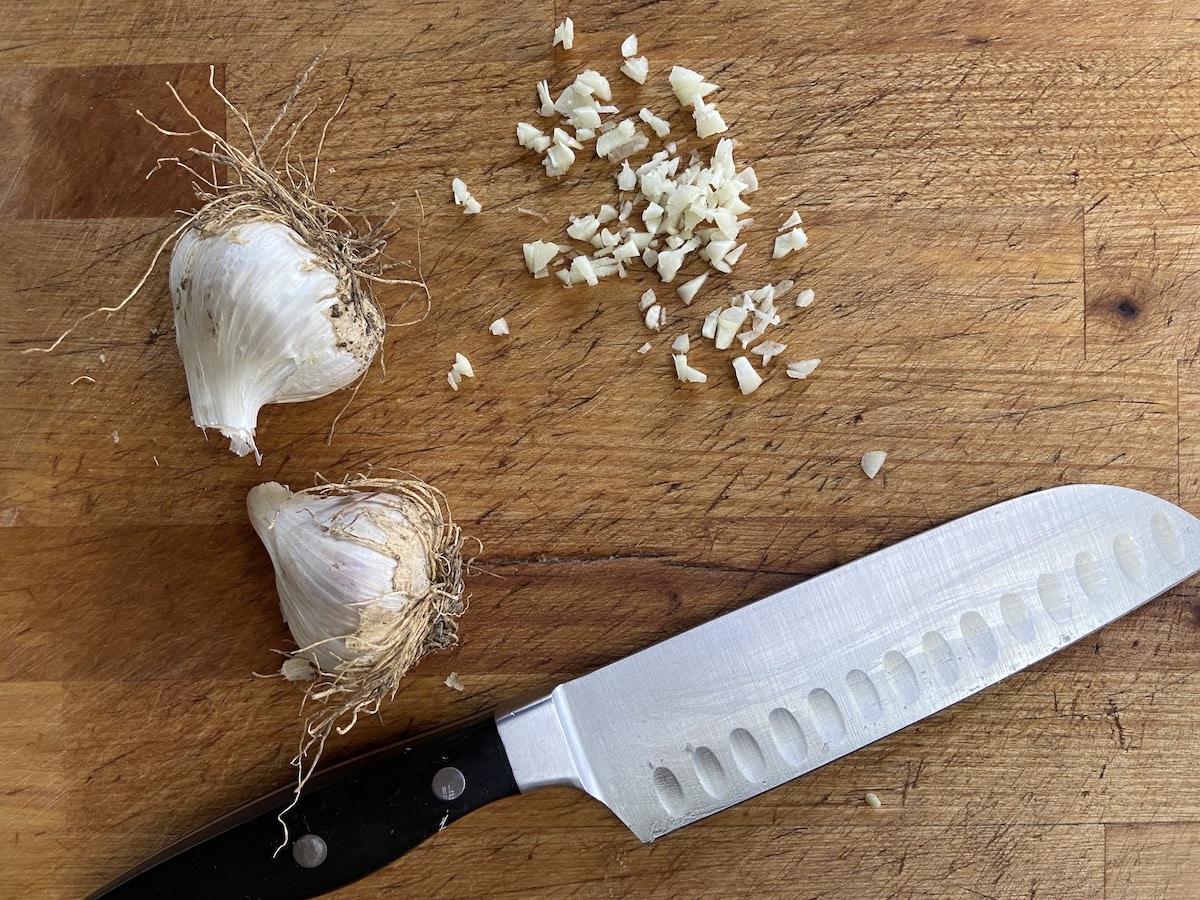
If you’ve been on the fence about planting garlic to harvest, cure and store for long term use, we couldn’t encourage you more to give this gourmet storage crop a go!
We have found garlic to be one of the few plants we can plant and forget (more or less). And it is such a treat to reap the benefits once springtime rolls around!
For more on gardening, check out:
10 Essential Storage Crops You Need To Grow
How To Store Potatoes From The Garden Long Term
Planting Potatoes with Long Sprouts – Everything you Need to Know
How To Create A Quarter Acre Self Sufficient Homestead Garden
DIY Seed Starting Mix with Compost
Starting Seeds Indoors Without Grow Lights

